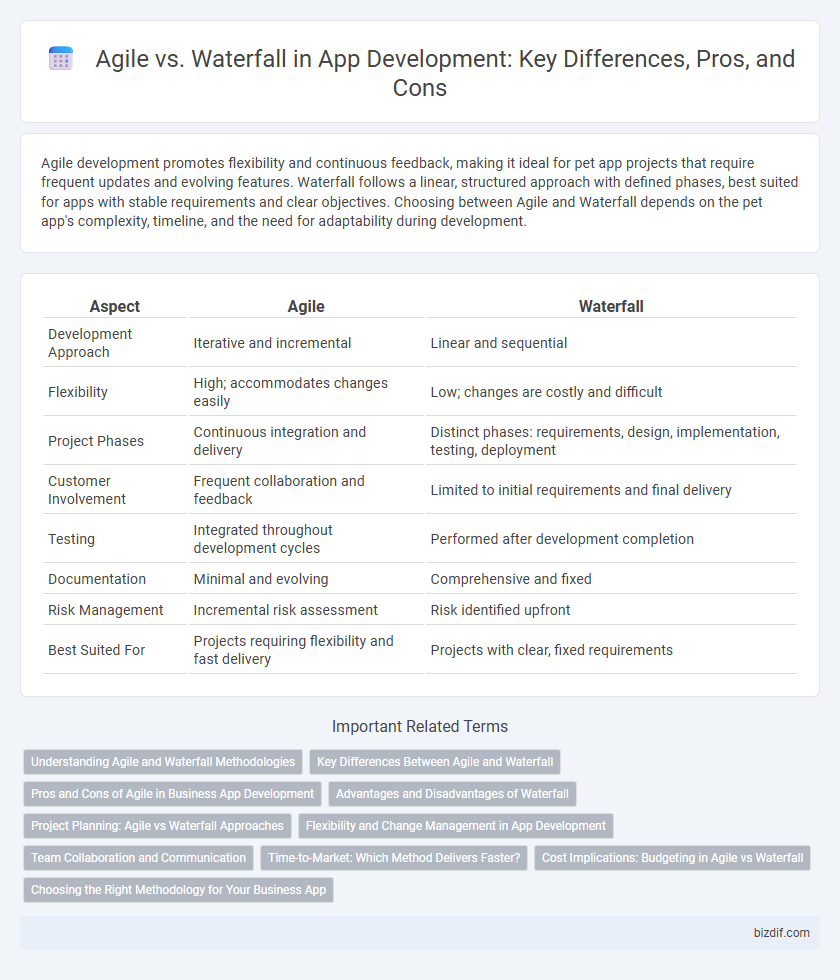Agile development promotes flexibility and continuous feedback, making it ideal for pet app projects that require frequent updates and evolving features. Waterfall follows a linear, structured approach with defined phases, best suited for apps with stable requirements and clear objectives. Choosing between Agile and Waterfall depends on the pet app's complexity, timeline, and the need for adaptability during development.
Table of Comparison
| Aspect | Agile | Waterfall |
|---|---|---|
| Development Approach | Iterative and incremental | Linear and sequential |
| Flexibility | High; accommodates changes easily | Low; changes are costly and difficult |
| Project Phases | Continuous integration and delivery | Distinct phases: requirements, design, implementation, testing, deployment |
| Customer Involvement | Frequent collaboration and feedback | Limited to initial requirements and final delivery |
| Testing | Integrated throughout development cycles | Performed after development completion |
| Documentation | Minimal and evolving | Comprehensive and fixed |
| Risk Management | Incremental risk assessment | Risk identified upfront |
| Best Suited For | Projects requiring flexibility and fast delivery | Projects with clear, fixed requirements |
Understanding Agile and Waterfall Methodologies
Agile methodology prioritizes iterative development, continuous feedback, and adaptive planning, enabling teams to respond swiftly to changing requirements during app development. Waterfall methodology follows a linear, sequential approach with distinct phases such as requirements gathering, design, implementation, testing, and deployment, making it suitable for projects with well-defined scope. Understanding these methodologies helps project managers select the best approach based on flexibility needs, project complexity, and stakeholder involvement.
Key Differences Between Agile and Waterfall
Agile development emphasizes iterative progress, flexibility, and customer collaboration, allowing teams to adapt quickly to changing requirements and deliver functional software in shorter cycles. Waterfall follows a linear, sequential approach with distinct phases such as requirements, design, implementation, testing, and deployment, making it less adaptable to changes but easier to manage with clearly defined milestones. Agile supports continuous feedback and improvement, whereas Waterfall relies on comprehensive documentation and upfront planning, impacting project visibility, risk management, and delivery timelines.
Pros and Cons of Agile in Business App Development
Agile in business app development offers increased flexibility, allowing teams to adapt quickly to changing requirements and deliver iterative improvements that enhance user satisfaction. It promotes continuous collaboration and transparency, reducing risks and ensuring faster time-to-market. However, Agile can lead to scope creep and requires strong team discipline and stakeholder involvement to maintain project focus and avoid potential delays.
Advantages and Disadvantages of Waterfall
Waterfall methodology offers clear structure, straightforward project timelines, and easy progress tracking, making it ideal for projects with well-defined requirements. However, its rigidity limits flexibility, making it difficult to accommodate changes once the development process begins. This often results in delayed issue detection and increased risk of rework, impacting overall efficiency and adaptability in dynamic app development environments.
Project Planning: Agile vs Waterfall Approaches
Agile project planning emphasizes iterative development with flexible, adaptive sprints that prioritize customer feedback and continuous improvement. Waterfall project planning follows a linear, sequential process with clearly defined phases and detailed documentation before moving to the next stage. Agile enables faster response to change, while Waterfall offers structured timelines and predictable deliverables.
Flexibility and Change Management in App Development
Agile methodology offers superior flexibility in app development by accommodating iterative changes and continuous feedback, allowing teams to adapt quickly to evolving requirements. Waterfall follows a linear, sequential process with rigid phases, making it challenging to incorporate changes once a stage is completed. Effective change management in Agile reduces risks and enhances product quality, while Waterfall's inflexibility can lead to delays and increased costs if modifications arise late in the project.
Team Collaboration and Communication
Agile methodology enhances team collaboration and communication through iterative cycles and daily stand-ups, enabling rapid feedback and continuous improvement. Waterfall follows a linear, sequential approach, which can limit real-time interaction and delay problem-solving until later stages. Agile's adaptive framework fosters transparency and shared responsibility, resulting in more cohesive and responsive development teams.
Time-to-Market: Which Method Delivers Faster?
Agile development accelerates time-to-market by enabling iterative releases and continuous feedback, allowing faster adaptation to changes and early delivery of functional features. Waterfall's sequential phases often extend project timelines due to rigid planning and late-stage testing. Teams prioritizing speed and flexibility typically achieve quicker results with Agile methodologies compared to the traditional Waterfall approach.
Cost Implications: Budgeting in Agile vs Waterfall
Agile app development typically offers more flexible budgeting through iterative cycles, allowing teams to adapt scope and resources dynamically, which can help prevent cost overruns. Waterfall budgeting requires detailed upfront cost estimation based on complete project requirements, often leading to rigid budgets with limited room for adjustment. While Waterfall may provide predictable expenses, Agile's adaptive approach often results in more efficient resource allocation and better control over development costs.
Choosing the Right Methodology for Your Business App
Choosing the right methodology for your business app development hinges on project complexity and timeline flexibility. Agile excels in adapting to evolving requirements and delivering incremental value, ideal for dynamic environments and frequent client feedback. Waterfall suits well-defined projects with clear stages and fixed scope, offering predictability and structured progress tracking.
Agile vs Waterfall Infographic

 bizdif.com
bizdif.com